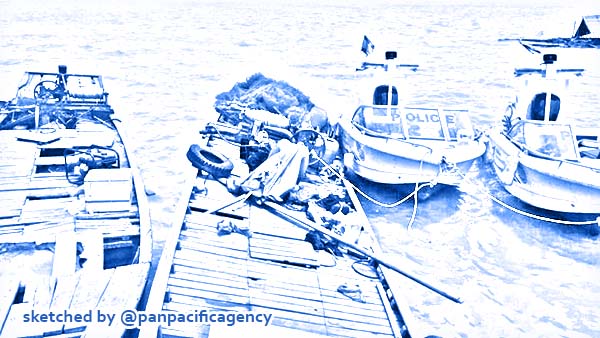Hundreds of Vietnamese fishing boats intrude into Chinese waters: Beijing-based think tank

The fishing boats were seized by Prey Veng authorities. Fresh News. Sketched by the Pan Pacific Agency.
BEIJING, Mar 7, 2020, SCMP. More than 300 Vietnamese fishing boats ventured into Chinese waters during February and some crews manipulated transponder signals to avoid being tracked or identified, according to a Beijing-based think tank, South China Morning Post reported.
While some observers disputed suggestions that the vessels were there to spy on Chinese military bases, the report highlighted the increasing tensions between China and Vietnam in the South China Sea as Beijing and Washington vie for greater influence in the region.
The report by the South China Sea Strategic Situation Probing Initiative, affiliated with Peking University, said 212 Vietnamese vessels entered Chinese waters to the southeast of Hainan, and 99 more entered Chinese waters in the Gulf of Tonkin.
Seventy-three Vietnamese vessels encroached into Chinese territorial waters beyond limits agreed with Vietnam, while some of those were reported within the 12 nautical mile limit off Guangxi Zhuang autonomous region, which borders Vietnam, it said.
The report said the crews of some of vessels overrode automatic identification transponders or used Chinese ID numbers, throwing law enforcement off their trail.
Vietnamese ships were also suspected by Chinese authorities of illegal, unreported and unregulated fishing in Chinese waters, it said.
The report suggested that Vietnamese ships had reconnoitred Chinese military bases and warships. The heaviest Vietnamese sea traffic was close to installations in Guangdong province and Hainan that serve naval operations in the South China Sea, it said.
Le Hong Hiep, a Vietnamese affairs expert from Singapore’s ISEAS – Yusof Ishak Institute, said the report lacked sufficient evidence to prove that the vessels may have entered Chinese waters for missions other than fishing.
“It’s questionable that all the vessels they mentioned in the report are Vietnamese vessels, since it’s possible for Chinese vessels to disguise themselves as Vietnamese,” Le said.
“And if the Vietnamese vessels went to Chinese waters for special missions instead of fishing, that’s copying from China’s playbook, as China has long been using its fishing fleet to support its official, military or intelligence gathering missions in the South China Sea.”
The report, released on Wednesday, comes as the United States edges closer to Vietnam, a vocal claimant in the disputed South China Sea.
US nuclear powered aircraft carrier USS Theodore Roosevelt docked at the Vietnamese coastal city of Da Nang on Thursday, and Vietnamese officials welcomed the crew, a sign of improving military ties between the two countries.
This was the second such visit since the end of the Vietnam war in 1975. In March 2018, the Carl Vinson became the first US carrier to dock in Vietnam in more than four decades.
Zhang Jie, a researcher at the Chinese Academy of Social Sciences, said the report indicated that China-US tensions in the South China Sea still ran high.
“The South China Sea issues have not been eased, they were only put aside temporarily because the two governments need to focus on something else,” Zhang said without elaborating.
Vietnam, which is the chair of the Association of Southeast Asian Nations this year, was expected to steer discussions towards South China Sea matters during meetings, Zhang said.
“Vietnam will definitely use this year ’s chairmanship to increase discussions and set the agenda related to the South China Sea issue,” she said. “But activities will not go too far to hurt Vietnam’s interest. Coupled with the current coronavirus epidemic, countries will definitely strengthen cooperation on non-traditional topics. So, in this sense, maritime issues will not become heated, but competition underneath is sure to intensify.”
Timothy Heath, senior international defence research analyst at US think tank Rand Corporation, said Vietnamese crew interference with ship transponders was more likely to be about evading capture for illegal fishing.
“Manipulation to disguise one’s activity or identity is unfortunately a common issue with fishing boats globally … The most likely reason is economic – the search for fishing stocks. This in turn may reflect the decline in the fisheries of the South China Sea due to overfishing,” Heath said.
He also said that Chinese fishing boats continued to violate the exclusive economic zones (EEZ) of many Asian neighbours.
“There is a need for more dialogue and consultation on how best to limit the unauthorised incursions in the EEZ of all countries by fishermen and gas exploration platforms,” Heath said.